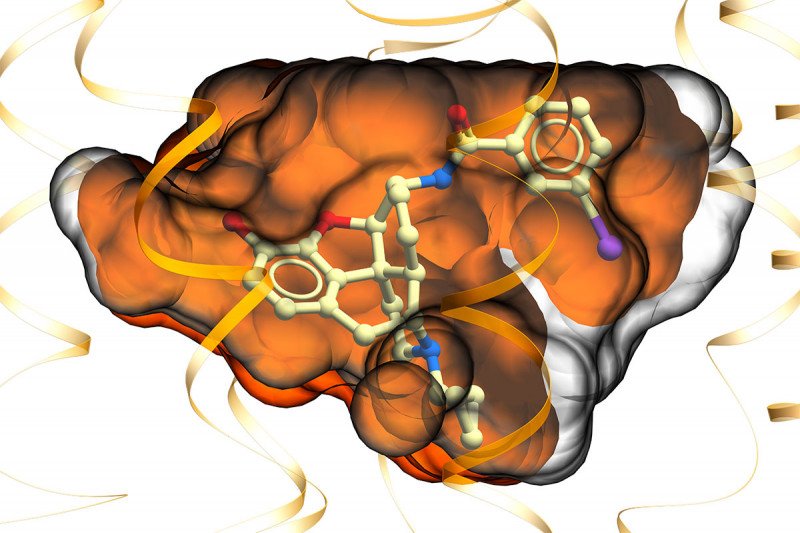
MSK researchers are designing new molecules that can block pain signals. The image above shows the molecule MP1104 binding into the pocket of the kappa opioid receptor (in orange).
The United States is in the midst of an opioid epidemic. According to the Centers for Disease Control and Prevention, 91 Americans die every day from opioid overdoses, and that figure is rising.
Researchers are working to combat this epidemic. Economics, psychology, and medicine all play a role. Chemistry also can be a factor by contributing to the development of safer opioid drugs that effectively treat pain but are less likely to lead to addiction or abuse.
Memorial Sloan Kettering medicinal chemist Susruta Majumdar has focused on this effort for more than a decade. He is part of a multicenter group of researchers publishing a paper in Cell that reports an inventive approach for developing safer opioid drugs. We spoke with Dr. Majumdar recently about this research.
Why are opioid drugs so likely to cause addiction and abuse?
All of the opioid drugs that are currently available target what is called the mu opioid receptor. These drugs include morphine, oxycodone, and fentanyl. When they bind to this receptor, which is found in nerve cells all over the body, they block the pathways that transmit pain signals to the brain.
But targeting the mu receptor has another effect on the nervous system. It gives you a feeling of euphoria, a high. It’s the same thing you feel when you have sex or eat chocolate or take some other drugs, like cocaine. One of the reasons people become addicted to opioids is because they’re constantly seeking that high.
How does your research address the issue of opioid addiction and abuse?
In addition to mu, there are two other opioid receptors that also block pain signals. They are called the kappa receptor and the delta receptor. In my research, we’re looking for ways to activate the kappa receptor. We think this approach has great potential. Drugs that target the kappa receptor can block pain signals without giving the feeling of euphoria that leads to abuse.
Unfortunately, kappa drugs that have been studied in the lab also have unwanted side effects, like frequent urination. But more importantly, they cause hallucinations and dysphoria, or feelings of unhappiness. Our goal is to design kappa drugs that will provide effective pain relief while avoiding these other effects.
How are you investigating this?
We’re using an approach called structure-based drug design. It’s built on the idea that once we know the shape of a protein, we can design a molecule that will fit into it exactly the way we want it to, like a key fitting into a lock.
In this case, that protein is the kappa opioid receptor. We have determined its shape, so now we can design drugs that bind to it in just the right way.
What does the new Cell study add to this area of research?
In 2015, our team at MSK reported that we had created a compound that binds very effectively to the kappa opioid receptor. We called the compound MP1104. We showed this molecule had the ability to reduce pain without the other negative effects associated with kappa opioids. We also showed that it blocked cocaine addiction in mice.
A team led by pharmacologist Bryan Roth at the University of North Carolina (UNC) at Chapel Hill then used our molecule to crystalize the kappa opioid receptor and determine its structure. Once they did that, our lab at MSK developed a library of other molecules that are related to MP1104 using structure-based drug design.
The new compounds were synthesized by MSK research scholar Rajendra Uprety and tested by postdoctoral researcher Tao Che at UNC. At least one of the molecules we made shows an ability to bind selectively to the kappa receptor over other opioid receptors.
To summarize our findings, MP1104 has made it possible to understand how kappa receptors are activated. In addition, having the crystal structure available will allow us and others to discover new kappa drugs that can relieve pain without causing the unhappy feelings that the current kappa drugs can cause.
What’s next for this research collaboration?
We now have several promising compounds that we can begin to test in animals in the lab. Our goal is to find the best candidates to eventually test in people.
These compounds also have potential for treating addiction to other drugs, including cocaine and alcohol, by blocking the brain’s reward system. So that is another important area to pursue.





